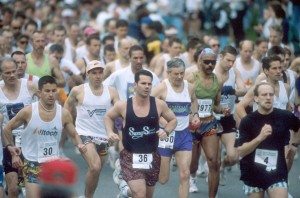Why we get running injuries; a new study shows it’s all about the impact and here are some suggestions to reduce the likelihood of injury.
As I tell our many patients who run, treating running injuries is something most healthcare practitioners learn to do. Understanding why you get injured and how to prevent future injuries is a very different approach to care that most runners really want. Helping them figure this out improves their running experience.
The NY Times recently discussed why running injuries occur in a new article, which raises some good points. The study they discussed looked at 240 female runners and followed their progress for a period of time. Their conclusions are that the runners who do not injure themselves have a softer impact at the ground. Most running shoemakers have been aware of the problem of impact, which is why so many shoes try to soften the impact or spread the force at the ground which has had minor success at best. Gait problems cannot be solved by a running shoe but can be alleviated somewhat by them.
 The legs work like springs, but various adaptations to one’s own gait may cause over and under striding when running which increases the force of impact at the ground with each step. When the spring effect does not absorb shock through the pelvis, and inefficient gait mechanics are present, the constant pounding is what causes pain and stress fractures. Diagnosing the injury does not go far enough; diagnosing the mechanics behind the problem is what helps runners overcome the problem since not doing so will result in other injuries and in the case of many runners, the cessation of the desire to run.
The legs work like springs, but various adaptations to one’s own gait may cause over and under striding when running which increases the force of impact at the ground with each step. When the spring effect does not absorb shock through the pelvis, and inefficient gait mechanics are present, the constant pounding is what causes pain and stress fractures. Diagnosing the injury does not go far enough; diagnosing the mechanics behind the problem is what helps runners overcome the problem since not doing so will result in other injuries and in the case of many runners, the cessation of the desire to run.
Many of our patients have been shown that by placing them on a treadmill and having them go to their normal running pace. Those who under and overstride typically hit the treadmill hard and you can hear the impact on the treadmill. Simply explained, those with high impact pound with each step, those with a lighter impact don’t.
When we place a pair of off-the-shelf foot orthotics in their running shoes, their stride on the video opens up and the sound of their impact becomes reduced. I have suggested the orthotic device levels the hips and helps improve leg symmetry as you stride, which can be seen on before and after videos.
A common compensation is to hunch the shoulders which is actually a subconscious way of decelerating, and it will also cause over and under striding as well as a higher impact on the treadmill. A simple coaching technique can help improve this bad habit which on video causes asymmetry in both the upper and lower body. By relaxing the shoulders and arms and keeping them moving forward rather than across the body improves symmetry and decreases ground impact.
One other thing they mention in the article and something we explain to runners is that those who run at a trot or 10.5-minute pace or longer are going up and down rather than forward, which is makes running a higher impact sport. Increasing gait efficiency and speed to 9.5-minute miles can decrease impact because the force is moving more forward than up and down, thereby decreasing the force of ground impact.
Check out the NY Times article here
Why We Get Running Injuries (and How to Prevent Them)
By Gretchen Reynolds February 10, 2016
Warm weather is on its way across the country “” really, it is, I promise “” and so are spring marathons, meaning that many people soon will begin a new or augmented running program. Many also will wind up sidelined by injury. But a new study suggests that being light on your feet could keep most runners healthy.
Running injuries are extremely common, with some statistics estimating that as many as 90 percent of runners miss training time every year due to injury.
But the underlying cause of many of these injuries remains in question. Past studies and popular opinion have blamed increased mileage, excess body weight, over-striding, modern running shoes, going barefoot, weak hips, diet, and rough pavement or trails. But most often, studies have found that the best indicator of a future injury is a past one, which, frankly, is not a helpful conclusion for runners hoping not to get hurt.
Read more
